
William Wordsworth was an English Romantic poet who, with Samuel Taylor Coleridge, helped to launch the Romantic Age in English literature with their joint publication Lyrical Ballads (1798).

Nether Stowey is a large village in the Sedgemoor district of Somerset, South West England. It sits in the foothills of the Quantock Hills, just below Over Stowey. The parish of Nether Stowey covers approximately 4 km², with a population of 1,373.
This article contains information about the literary events and publications of 1797.

The Quantock Hills west of Bridgwater in Somerset, England, consist of heathland, oak woodlands, ancient parklands and agricultural land. They were England's first Area of Outstanding Natural Beauty, designated in 1956.
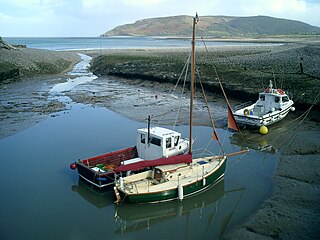
Porlock is a coastal village in Somerset, England, 5 miles (8 km) west of Minehead. At the 2011 census, the village had a population of 1,440.

Ernest Hartley Coleridge (1846–1920) was a British literary scholar and poet. He was son of Derwent Coleridge and grandson of Samuel Taylor Coleridge.
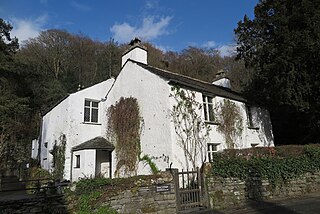
Dove Cottage is a house on the edge of Grasmere in the Lake District of England. It is best known as the home of the poet William Wordsworth and his sister Dorothy Wordsworth from December 1799 to May 1808, where they spent over eight years of "plain living, but high thinking". During this period, William wrote much of the poetry for which he is remembered today, including his "Ode: Intimations of Immortality", "Ode to Duty", "My Heart Leaps Up" and "I Wandered Lonely as a Cloud", together with parts of his autobiographical epic, The Prelude.
Nationality words link to articles with information on the nation's poetry or literature.
Culbone is a hamlet consisting of little more than the parish church and a few houses, in the parish of Oare in the Exmoor National Park, Somerset, England. As there is no road access it is a two-mile walk from Porlock Weir, and some four miles from Porlock itself.

The Coleridge Way is a 51-mile (82 km) long-distance trail in Somerset and Devon, England.

Roadwater is a village 3 miles (5 km) south-west of Williton, on the northern edge of the Exmoor National Park, in Somerset, England.
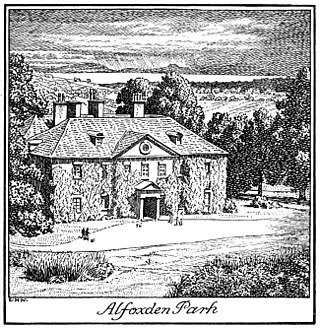
Alfoxton House, also known as Alfoxton Park or Alfoxden, is an 18th-century country house in Holford, Somerset, England, within the Quantock Hills Area of Outstanding Natural Beauty. The present house was rebuilt in 1710 after the previous building was destroyed in a fire.
Fears in Solitude, written in April 1798, is one of the conversation poems by Samuel Taylor Coleridge. The poem was composed while France threatened to invade Great Britain. Although Coleridge was opposed to the British government, the poem sides with the British people in a patriotic defense of their homeland. The poem also emphasizes a desire to protect one's family and to live a simple life in harmony with nature. The critical response to the poem was mixed, with some critics claiming that the work was "alarmist" and anti-British.

Greta Hall is a house in Keswick in the Lake District of England. It is best known as the home of the poets Samuel Taylor Coleridge and Robert Southey.
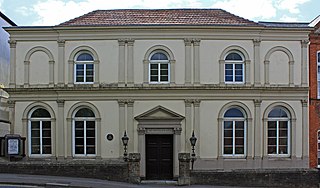
Taunton Unitarian Chapel is on Mary Street, Taunton, Somerset, England. It was built in the early 18th century as a Baptist chapel, but later adopted Unitarianism. The exterior was extensively renovated in the 19th century in an Italianate style. The chapel has been designated as a Grade II* listed building.

Thomas Poole was a Somerset tanner, Radical philanthropist, and essayist, who used his wealth to improve the lives of the poor of Nether Stowey, his native village. He was a friend of several writers in the British Romantic movement, a benefactor of Samuel Taylor Coleridge and his family, and an influence on the poems of Wordsworth.
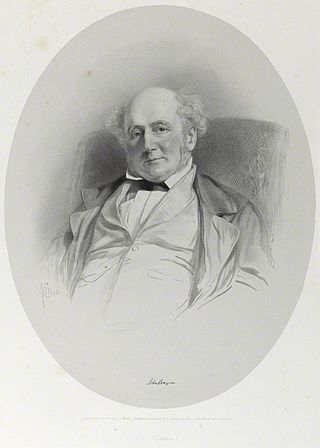
John Kenyon (1784–1856) was an English verse-writer and philanthropist, now known as a patron of Robert Browning.

Allan Bank is a grade II listed two-storey villa standing on high ground slightly to the west of Grasmere village in the heart of the Lake District. It is best known for being from 1808 to 1811 the home of William Wordsworth, but it was also occupied at various times by Dorothy Wordsworth, Dora Wordsworth, Thomas De Quincey, Samuel Taylor Coleridge, Thomas Arnold, Matthew Arnold and Canon Hardwicke Rawnsley. It is now owned by the National Trust and is open to the public.

3, The Grove, Highgate, in the London Borough of Camden, is a 17th-century house built by William Blake. In the 19th century it was home of the poet Samuel Taylor Coleridge; in the 20th, the novelist J. B. Priestley; and in the 21st, the model Kate Moss. It is a Grade II* listed building.


















